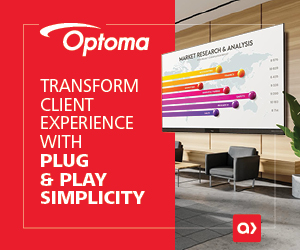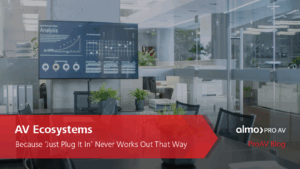Revisiting ADA Mounting Requirements
Wut?
So I can’t locate a camera in between two wall-mounted displays because that will be higher than 48 inches AFF? Plus, a typical PTZ camera sticks out more than 4 inches once it’s on a mount and has cables hanging out the back. Do I need to go back and place all of my cameras in recessed wall boxes?
This is where I love to go to the source materials rather than second-hand interpretations. I read things like the ADA Standard, the NEC as well as other codes, standards and industry reference sources.
The ADA Standards for Accessible Design are found here: https://www.ada.gov/law-and-regs/design-standards/2010-stds/ so you can read it for yourself or follow along.
MOUNTING HEIGHTS
It’s always good to look at the definitions in a Standard. Let’s look at the definition of an Operable Part and an Element in the ADA Standard.
Operable Part. A component of an element used to insert or withdraw objects, or to activate, deactivate, or adjust the element.
Element. An architectural or mechanical component of a building, facility, space, or site.
This includes things like light switches, electrical receptacles, environmental and appliance controls, security, intercom systems, etc. Prudence would dictate this also includes the control panels and signal connections for an audiovisual system as well as any loadable media like SD cards and thumb drives.
Does even an able-bodied person need access to a PTZ Camera? What “Operable Parts” are normally accessed on a camera? None. It is accessed and controlled either through a remote or a control system, so I don’t see a camera qualifying as an Operable Part or an Element.
However, we do see the height restriction requirements for Operable Parts in 309 of the ADA Standard.
309 Operable Parts
309.3 Height. Operable parts shall be placed within one or more of the reach ranges specified in 308.
And 309 of the Standard refers us to 308 of the Standard for the reach ranges.
ADA 308.2.1 and 308.3.1 reveal the mounting height requirements for unobstructed forward or side reach from a wheelchair.
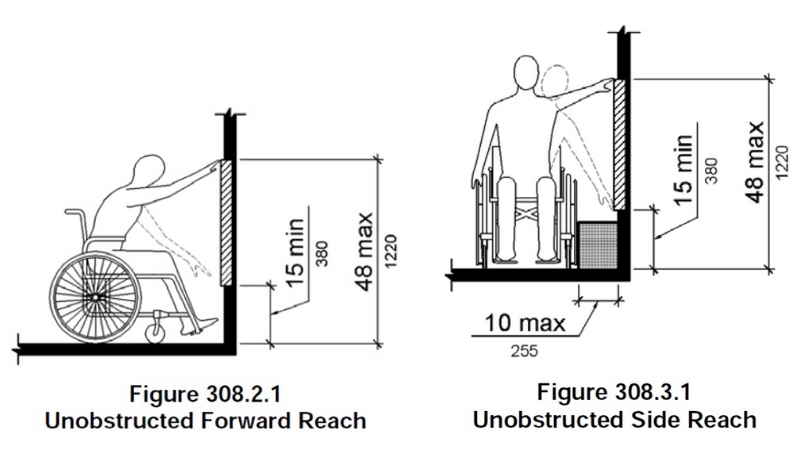
So while cameras should be mounted at eye height (48 inches AFF) to maintain eye contact with the far side, I can mount a camera higher on the wall in between two displays if that’s the best compromise given ceiling height and display location on the wall.
PROTRUSION LIMITS
204 of the ADA Standard tells us about Protruding Objects.
204 Protruding Objects
204.1 General. Protruding objects on circulation paths shall comply with 307
So we need to know what a circulation path is and we also find that in the definitions.
Circulation Path. An exterior or interior way of passage provided for pedestrian travel, including but not limited to, walks, hallways, courtyards, elevators, platform lifts, ramps, stairways, and landings.
So the protrusion limits apply to circulation paths. Does this definition of a Circulation Path include a classroom or meeting room? The definition is about passageways and I don’t see “rooms” called out as a being a circulation path.
Protrusion Limits for circulation paths are found in 307 of the Standard.
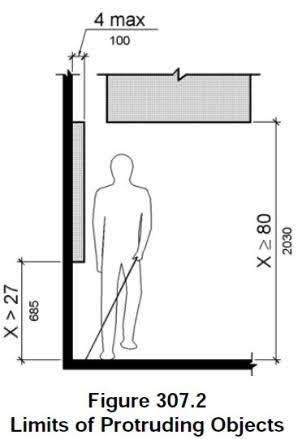 307.2 Protrusion Limits.
307.2 Protrusion Limits.
Objects with leading edges more than 27 inches (685 mm) and not more than 80 inches (2030 mm) above the finish floor or ground shall protrude 4 inches (100 mm) maximum horizontally into the circulation path
So I’m okay with a display or camera protruding out more than 4 inches in the front of a classroom, meeting room or conference room.
I don’t think however, that I would want a projector or camera hanging lower than 80 inches AFF in the middle of a room or even a display on a swing arm hanging lower than 80 inches AFF from a side wall. I also might not wish to exceed the 4 in. protrusion limit along the side and rear walls even though it’s not required.
It’s interesting to see that a leading mount manufacturer says of one of their display mounts, “Low-profile 1″ (25 mm) depth facilitates ADA compliance for typical AV design requirements.” “Facilitates” does not equal compliance.
Even the facilitating mount can run afoul of ADA if the mount/display combo protrudes more than 4 inches from the wall in a Circulation Path.
Can you get around the 4-in. protrusion limitation? Sure. Build in a permanent credenza below the wall-mounted device. Problem solved.
ASSISTIVE LISTENING SYSTEMS
 Something that is often overlooked in seeking ADA compliance is the availability of an Assistive Listening System.
Something that is often overlooked in seeking ADA compliance is the availability of an Assistive Listening System.
219.2 Required Systems. In each assembly area where audible communication is integral to the use of the space, an assistive listening system shall be provided.
EXCEPTION: Other than in courtrooms, assistive listening systems shall not be required where audio amplification is not provided.
The definition of an Assembly Area is quite broad, and you see that when you read the Standard.
SUMMARY
Really, ADA compliance is not so much about the equipment as it is about the equipment’s implementation. The only exception that comes to mind is a lectern/presentation station that has a motor for height adjustment. Components of a Hearing Assistance System are not “ADA Compliant” in and of themselves. (Except that an ALS receiver must have a 1/8 in. mono jack to be a compliant receiver. See 706.2.) However, they can be part of an ADA-compliant system.
I hope this has helped separate fact from fiction. If you need more information about products that will help keep you and your clients ADA-compliant on a project, reach out to us here at Exertis Almo. We would be happy to help.
Want to learn more? Check out “The Modern Meeting Room” blog for more insights on audiovisual design.


 In video conferencing systems, positional tracking technology is pivotal for enhancing auto-tracking and speaker framing capabilities. Auto-tracking enables cameras to autonomously follow speakers as they move within a room, utilizing visual cues like face detection and body movement to adjust camera orientation. This feature ensures that speakers remain within view. Speaker framing, on the other hand, focuses on centrally positioning the active speaker in the camera’s frame, particularly beneficial in multi-participant settings. By analyzing audio cues, such as voice activity detection and microphone array data, conferencing systems triangulate the speaker’s location using techniques like time delay of arrival (TDOA) and adaptive beamforming. This dual approach, combining audio source localization with visual tracking, ensures comprehensive coverage and accurate framing during video conferences.
In video conferencing systems, positional tracking technology is pivotal for enhancing auto-tracking and speaker framing capabilities. Auto-tracking enables cameras to autonomously follow speakers as they move within a room, utilizing visual cues like face detection and body movement to adjust camera orientation. This feature ensures that speakers remain within view. Speaker framing, on the other hand, focuses on centrally positioning the active speaker in the camera’s frame, particularly beneficial in multi-participant settings. By analyzing audio cues, such as voice activity detection and microphone array data, conferencing systems triangulate the speaker’s location using techniques like time delay of arrival (TDOA) and adaptive beamforming. This dual approach, combining audio source localization with visual tracking, ensures comprehensive coverage and accurate framing during video conferences.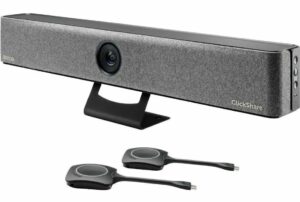 Barco has introduced
Barco has introduced 
 I’ve even seen an increase in requests for wireless for city council chambers. Read that again. For a city council. They sit behind a council table. Your typical local council is probably well known for being intractable and immovable so I can’t fathom the need for a wireless in that application. Hardwired mics only.
I’ve even seen an increase in requests for wireless for city council chambers. Read that again. For a city council. They sit behind a council table. Your typical local council is probably well known for being intractable and immovable so I can’t fathom the need for a wireless in that application. Hardwired mics only. There is only one absolute rule when not to use a hardwired microphone: the baptistry. Never, ever place a hardwired microphone within reach of a baptistry. In the mid-2000s, Reverend Kyle Lake of University Baptist Church in Waco, TX was electrocuted as his hand made contact with a hardwired microphone connected to the church’s audio system. It wasn’t the fault of the correctly installed audio system or phantom power, it was a short circuit that had developed in the baptismal water heater. The investigation revealed that the older water heater wasn’t up to current electrical codes and it lacked a ground wire. When Reverend Lake touched the microphone, he became an inadvertent electrical path as the electricity sought a way to return to its source. If you need a wireless, the baptistry is the perfect application.
There is only one absolute rule when not to use a hardwired microphone: the baptistry. Never, ever place a hardwired microphone within reach of a baptistry. In the mid-2000s, Reverend Kyle Lake of University Baptist Church in Waco, TX was electrocuted as his hand made contact with a hardwired microphone connected to the church’s audio system. It wasn’t the fault of the correctly installed audio system or phantom power, it was a short circuit that had developed in the baptismal water heater. The investigation revealed that the older water heater wasn’t up to current electrical codes and it lacked a ground wire. When Reverend Lake touched the microphone, he became an inadvertent electrical path as the electricity sought a way to return to its source. If you need a wireless, the baptistry is the perfect application. Imagine a large-scale conference, a live concert, or a corporate presentation. Behind the scenes, there’s a complex network of AV equipment working tirelessly to deliver an immersive experience to the audience. At the heart of this network lies the network switch, serving as a central hub that connects various AV devices such as cameras, microphones, speakers, displays, and media servers.
Imagine a large-scale conference, a live concert, or a corporate presentation. Behind the scenes, there’s a complex network of AV equipment working tirelessly to deliver an immersive experience to the audience. At the heart of this network lies the network switch, serving as a central hub that connects various AV devices such as cameras, microphones, speakers, displays, and media servers.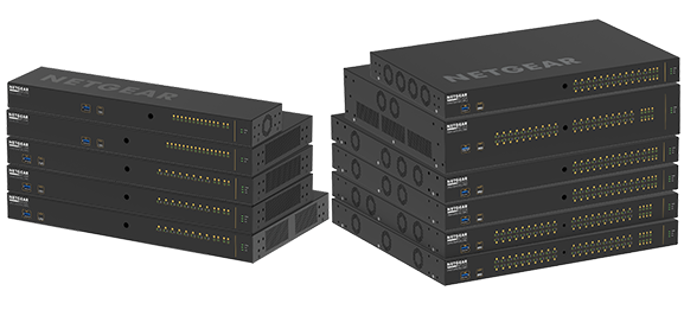
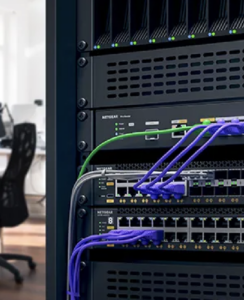 As technology continues to evolve, network switches will continue to play a pivotal role in shaping the future of professional AV, enabling new possibilities and pushing the boundaries of what is possible in terms of performance, reliability, and scalability. One network switch manufacturer leading the charge in the Pro AV industry is Netgear. They provide purpose-built layer 3 switches with preconfigured network protocols like IGMP snooping, multicast routing, and fast leave mechanisms, to optimize multicast traffic delivery and conserve network bandwidth. Netgear also continues to develop switches that include certified profile setup configurations including NDI, SRT, Dante, AES, AVB and many others for audio/video/lighting/control. Adding a simplified custom AV user interface that doesn’t require an IT administrator to configure, and generous PoE power for all AV components in the system is a grand slam for Pro AV integrators.
As technology continues to evolve, network switches will continue to play a pivotal role in shaping the future of professional AV, enabling new possibilities and pushing the boundaries of what is possible in terms of performance, reliability, and scalability. One network switch manufacturer leading the charge in the Pro AV industry is Netgear. They provide purpose-built layer 3 switches with preconfigured network protocols like IGMP snooping, multicast routing, and fast leave mechanisms, to optimize multicast traffic delivery and conserve network bandwidth. Netgear also continues to develop switches that include certified profile setup configurations including NDI, SRT, Dante, AES, AVB and many others for audio/video/lighting/control. Adding a simplified custom AV user interface that doesn’t require an IT administrator to configure, and generous PoE power for all AV components in the system is a grand slam for Pro AV integrators.



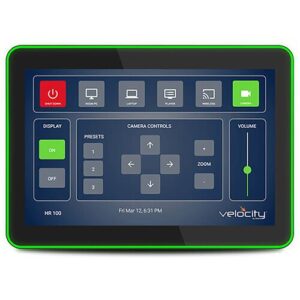
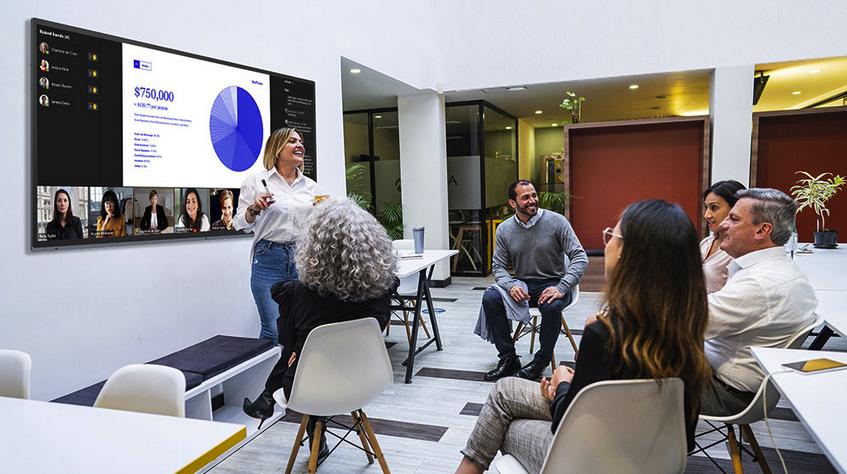
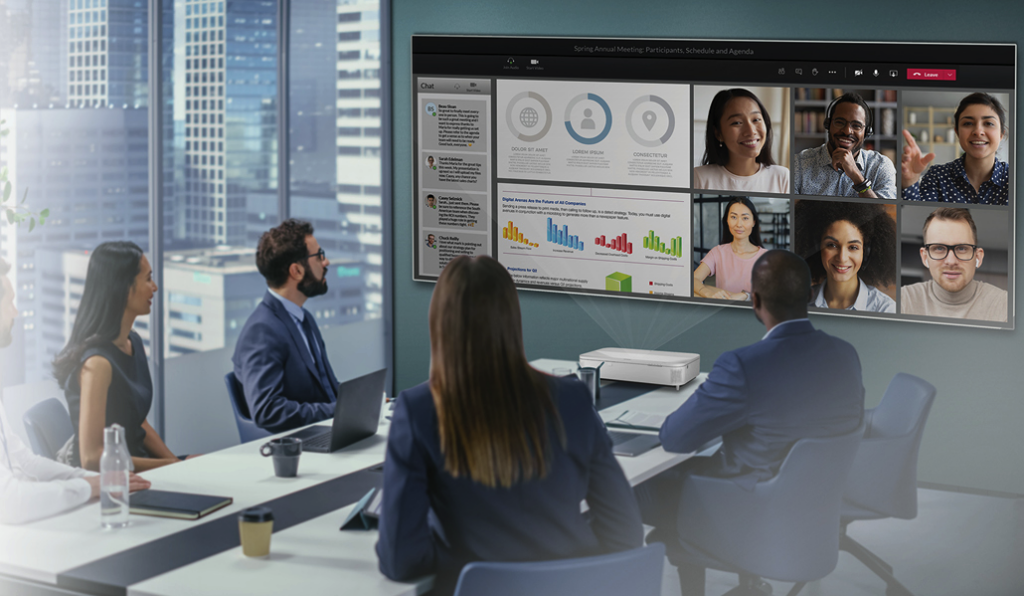
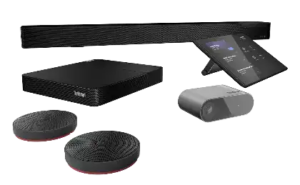 AI-powered cameras and microphones, such as those offered by
AI-powered cameras and microphones, such as those offered by 